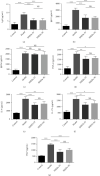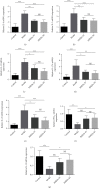Stem Cells from Human Exfoliated Deciduous Teeth Attenuate Atopic Dermatitis Symptoms in Mice through Modulating Immune Balance and Skin Barrier Function
- PMID: 35909660
- PMCID: PMC9334056
- DOI: 10.1155/2022/6206883
Stem Cells from Human Exfoliated Deciduous Teeth Attenuate Atopic Dermatitis Symptoms in Mice through Modulating Immune Balance and Skin Barrier Function
Abstract
Atopic dermatitis (AD) is a chronic skin inflammatory disease associated with immune abnormalities and disrupted skin barrier function. Mesenchymal stem cells (MSCs) have been suggested as an alternative therapeutic option in AD. Stem cells from human exfoliated deciduous teeth (SHEDs) are a unique postnatal stem cell population with high immunomodulatory properties. The aim of this study was to explore the effects of SHEDs on AD in the BALB/c mouse model induced by 2,4-dinitrochlorobenzene (DNCB). SHEDs were administrated intravenously or subcutaneously, and clinical severity, histopathological findings, skin barrier function, and organ indexes were evaluated. Skin tissue cytokine mRNA levels and serum cytokine protein levels were further analysed. SHED administration significantly alleviated AD clinical severity, including dermatitis scores, ear thickness, scratching behaviour, and infiltration of mast cells. In addition, disrupted skin barrier function and enlarged spleens were restored by SHED administration. Further, SHED treatment reduced the levels of IgE, IgG1, and thymic stromal lymphopoietin (TSLP) in the serum and the modulated expression of Th1-, Th2-, and Th17-associated cytokines in skin lesions. In conclusion, SHEDs attenuated AD-like skin lesions in mice by modulating the immune balance and skin barrier function. SHEDs could be a potential new treatment agent for AD.
Copyright © 2022 Hao Xiong et al.
Conflict of interest statement
The authors declare no conflict of interest.
Figures





Similar articles
-
Fermented Morinda citrifolia (Noni) Alleviates DNCB-Induced Atopic Dermatitis in NC/Nga Mice through Modulating Immune Balance and Skin Barrier Function.Nutrients. 2020 Jan 18;12(1):249. doi: 10.3390/nu12010249. Nutrients. 2020. PMID: 31963703 Free PMC article.
-
Lithospermum erythrorhizon Alleviates Atopic Dermatitis-like Skin Lesions by Restoring Immune Balance and Skin Barrier Function in 2.4-Dinitrochlorobenzene-Induced NC/Nga Mice.Nutrients. 2021 Sep 15;13(9):3209. doi: 10.3390/nu13093209. Nutrients. 2021. PMID: 34579088 Free PMC article.
-
Deacetylasperulosidic Acid Ameliorates Pruritus, Immune Imbalance, and Skin Barrier Dysfunction in 2,4-Dinitrochlorobenzene-Induced Atopic Dermatitis NC/Nga Mice.Int J Mol Sci. 2021 Dec 25;23(1):226. doi: 10.3390/ijms23010226. Int J Mol Sci. 2021. PMID: 35008651 Free PMC article.
-
FGF-21 fusion proteins ameliorate atopic dermatitis by inhibiting the TLR/TSLP signaling pathway: Anti-inflammatory and skin barrier repair effects.Int Immunopharmacol. 2025 Jun 26;159:114920. doi: 10.1016/j.intimp.2025.114920. Epub 2025 May 26. Int Immunopharmacol. 2025. PMID: 40424659 Review.
-
Mesenchymal Stem Cells and Atopic Dermatitis: A Review.Front Cell Dev Biol. 2020 May 14;8:326. doi: 10.3389/fcell.2020.00326. eCollection 2020. Front Cell Dev Biol. 2020. PMID: 32478072 Free PMC article. Review.
Cited by
-
Therapeutic roles of natural and engineered mesenchymal stem cells and extracellular vesicles in atopic dermatitis.Regen Ther. 2025 Jun 4;30:123-135. doi: 10.1016/j.reth.2025.05.009. eCollection 2025 Dec. Regen Ther. 2025. PMID: 40521136 Free PMC article. Review.
-
Dental Pulp Stem Cells for Bone Tissue Engineering: A Literature Review.Stem Cells Int. 2023 Oct 11;2023:7357179. doi: 10.1155/2023/7357179. eCollection 2023. Stem Cells Int. 2023. PMID: 37868704 Free PMC article. Review.
-
Apoptotic Vesicles Derived from Mesenchymal Stem Cells Ameliorate Hypersensitivity Responses via Inducing CD8+ T Cells Apoptosis with Calcium Overload and Mitochondrial Dysfunction.Adv Sci (Weinh). 2025 Jun;12(22):e2407446. doi: 10.1002/advs.202407446. Epub 2025 Mar 16. Adv Sci (Weinh). 2025. PMID: 40089865 Free PMC article.
-
Therapeutic effects of mesenchymal stem cells and their derivatives in common skin inflammatory diseases: Atopic dermatitis and psoriasis.Front Immunol. 2023 Feb 20;14:1092668. doi: 10.3389/fimmu.2023.1092668. eCollection 2023. Front Immunol. 2023. PMID: 36891306 Free PMC article. Review.
-
SHED-derived exosome-mimetics promotes rotator cuff tendon-bone healing via macrophage immunomodulation through NF-κB suppression and autophagy activation.Mater Today Bio. 2025 Jul 28;34:102146. doi: 10.1016/j.mtbio.2025.102146. eCollection 2025 Oct. Mater Today Bio. 2025. PMID: 40809349 Free PMC article.
References
MeSH terms
Substances
LinkOut - more resources
Full Text Sources

